PHNOM PENH, Cambodia (AP) — Palms clasped together, tears welling in her eyes, Sam Somaly looked into the camera and issued a desperate plea to three siblings she had not seen in nearly 40 years — family lost a lifetime ago to a nightmare that still haunts Cambodia today.
"I am your sister. I am looking for you," she said, her voice quavering. "If you hear this ... please come to me. I miss you so much. I'm getting sick because I miss you so much."
When the Khmer Rouge seized Cambodia in 1975, they literally broke families apart as they systematically emptied cities and forced this Southeast Asian nation's entire population to work in the countryside in a bizarre attempt to construct an ultra-communist agrarian society.
Somaly knew her parents and one brother were among the nearly 2 million people who succumbed to overwork, starvation and execution during those dark days. But the fate of two remaining brothers and a sister has always been a mystery, a struggle she likens to "finding a needle at the bottom of the sea."
She has no photos, no birth certificates, no other clues that might help in her search. Two of the siblings were so young when they were separated, they might not even remember her name — or the ones they were given at birth. Today, Somaly probably couldn't even recognize them if they passed on the street.
But when she had all but given up, a glimmer of hope came not from a government aid program or a humanitarian group, but reality TV.
A show called "It's Not a Dream" has transformed the darkest episode in Cambodian history into one of the modern world's rawest forms of entertainment. It has reunited dozens of families separated by the terror of the Khmer Rouge, and when Somaly contacted the station for help, a crew came to film her story.
"I feel like I'm living alone, in the middle of the ocean," she said in a six-minute video first broadcast in March 2014.
The scene ended with an announcement urging anyone who might know Somaly's siblings to call the station's hotline.
For months, there was no response.
___
Somaly's family exists for her today only in the furthest recesses of memory — fuzzy snapshots that are growing dimmer with the passage of time.
When black-clad Khmer Rouge fighters marched into Phnom Penh on April 17, 1975, her family was forced along with the rest of the city's inhabitants — even its hospital patients — to evacuate. The country's new rulers believed they were creating rural communist "utopia," and everyone was required to help.
Somaly was around 9 at the time, and at a train station outside the capital, she remembers soldiers firing in the air as they ordered people to board. The corpses of those who had refused lay beside the tracks.
In the chaos, she was separated from her family.
The Khmer Rouge banned religion, private property and money, and they viewed family bonds as a threat to the state. They separated husbands from wives, parents from children, brothers from sisters.
Somaly's family ended up in in the northern province of Battambang, where they were dispatched to separate villages. She managed to see some of them on rare occasions — one at a time, briefly, and sometimes only at a distance while they spent 12-hour days digging canals, building dams and tending to rice paddies.
When Vietnamese forces invaded in 1979 and put the Khmer Rouge on the run, Somaly was briefly reunited with her youngest brother, then about 6. But their reunion ended two days later when regime soldiers ambushed the Vietnamese army convoy they had been following. Rockets thundered down, and the pair was separated again.
A year later, Somaly returned to Phnom Penh to try to find her old home — a tiny wooden shack near a hospital that treated soldiers. But her memory was faint and the city had changed. She never found it.
A single clue emerged in the 1980s when a friend in Battambang excitedly recounted hearing a local radio broadcast mentioning what she thought was the name of her older brother — a man looking for lost siblings. They listened together for days, but the announcement was never repeated.
The broadcast was likely engineered by the Cambodian Red Cross, which over the last quarter-century has helped reunite 5,423 families, or about 27,000 people, according to Mam Daro, an official who oversees a reunification project for the organization. Some 4,500 other appeals remain unresolved.
Daro said the number of those applying for help has steadily decreased in recent years. Survivors are slowly dying off, or have given up. Many, like Somaly, were not even aware of the program.
Cambodia also remains a poor, developing nation. Few people can afford to mount a nationwide search, and there are few places to turn for help. Government officials contacted by The Associated Press said they were unaware of any state-sponsored effort to reunite families.
In 2009, Bayon TV sensed it could fill the gap, and the station began broadcasting appeals for people still looking for loved ones. Seven months later, in mid-2010, the weekly show was on air.
Nearly five years and 48 reunions later, "It's Not a Dream" has proven to be a hit among older generations who experienced the 1970s trauma.
More than 1,000 people have applied to the station for help, and producer Prak Sokhayouk has 12 staff members who prioritize cases they think they can solve. Those involving children who were under 10 in the 1970s are among the toughest, she said, not only because they were too young to recall key details, but because they were often renamed by their new families. Precious photos were also lost or destroyed — sometimes by families themselves to prevent Khmer Rouge cadres — who were killing anyone deemed educated or urban — from identifying them.
In Somaly's case, staff typed the names of her family into a national election database. No matches came up. But with possibly three siblings and more extended family likely alive somewhere in Cambodia, they thought they had a chance.
There was little to do but broadcast her story, though, and wait.
___
With its schmaltzy music, bluish stage lights, and studio audience, "It's Not a Dream" is very much stagecraft — so much so, that the show's producer said "some viewers have asked us, is this reality or a drama? Are those actors?"
That's because Cambodians "aren't used to seeing people so emotional like this, in front of the camera," Sokhayouk said. "But we're not making it up. We're just asking people to tell their stories, to explain what happened to them, and emotions come with that."
The hour-long show has reunited mothers and sons, brothers and sisters — and it always ends dramatically, with tears.
But it does not appeal to everyone. Most Cambodians alive today were born after the genocide, and Sokhayouk says they've had a tougher time getting younger viewers to tune in.
"They say it's a sad story to watch. They don't want to see people crying," Sokhayouk said. "Some young people don't believe the war was so cruel. I didn't either, until I started listening to the stories that started coming in."
There is also the question of whether a TV show is the best way to help families torn apart by a genocidal regime, though the people who benefit are clearly grateful and ready to take part.
Dy Khamboly of the Sleuk Rith Institute, which studies the Khmer Rouge period, said he supports anything "that helps the Cambodian people deal with their past" or helps educate younger generations. But he expressed reservations about "any effort that is implicated with business orientation or using the suffering of the people as part of the entertainment."
Khamboly declined to comment specifically about "It's Not a Dream," and said his words were meant generally, in caution.
Sokhayouk said Bayon TV does not care about ratings, and that the aim of the show was humanitarian.
"Many people have already given up hope (of finding their loved ones)," Sokhayouk said. "But they watch and think, 'This is probably my one last chance.'"
___
In July 2014, four months after Somaly's video plea aired, a retired policeman was channel-surfing and stumbled across a morning repeat of Somaly's clip. He did not recognize her, but he did recognize a name he hadn't heard in years — that of her father, Sam Seng.
Aov Vantha, 64, had known Somaly's parents well, and visited their Phnom Penh home regularly in the early '70s. Any remaining doubts disappeared when Somaly mentioned three other names he knew: her missing siblings, Sam Phalla, Sam Somala and Sam Sophath.
Somaly "seemed so lonely ... my heart just went out to her," Vantha later recalled at his home, an hour's drive from the capital. "All this time, we never searched for her, because we thought she was dead."
After the Khmer Rouge fell, most families trekked back to their homelands, but Somaly never did because she thought, wrongly, that she was born in Phnom Penh. In reality, she came from a village next to Vantha's from which her family had fled to escape fighting in the early 1970s.
Vantha called Bayon TV, told the station what he knew and asked expectantly: "When can I see her?"
"You must be patient," came the reply.
The reunion, of course, would take place on TV. Until then, Somaly would know nothing.
Sokhayouk, the producer, said the main factor behind delaying it was to allow more time to find at least one of her brothers or sisters. "We're in no way trying to prolong their pain," she said.
Staff also had to fact-check Vantha's claim to be absolutely sure they were bringing the right people back together. They interviewed other family members by phone, and in November, a TV crew came out to interview Vantha and another cousin for a video that would air when the reunion took place.
That happened last month. Somaly was invited to the studio to recount her story with two other survivors.
The station did not tell her that 15 of her relatives, mostly cousins from her mother's side of the family, would be secretly waiting behind a partition just off stage.
___
When taping got underway, a rapt audience of mainly older Cambodians looked on.
The original video that featured Somaly nine months earlier was repeated, and then came a new one featuring another cousin, and Vantha slicing banana trees on his farm. They both said how much they longed to see her again.
When it was over, the presenter, a smartly dressed young woman with heavy makeup, sat with Somaly on a red couch.
"Do you recognize these people?" she asked.
Somaly said she did not.
But the gravity of the intensely bittersweet moment was dawning: Somaly was about to meet long-lost relatives, but not the ones she had wanted most desperately to find.
"They are your cousins," the presenter said. "Do you want to meet them now?"
On cue, the sound of a violin playing the "West Side Story" tune "Somewhere" filled the studio, and one of the cousins from the video walked on stage.
Somaly, almost dazed, staggered into his embrace. The rest of the family, including Vanth, streamed out and surrounded her as the audience applauded.
When the cameras stopped rolling, a cousin stepped forward and asked, "Do you remember when we used to play hide-and-seek?"
Somaly shook her head.
Later, they would drive an hour outside Phnom Penh, down dusty dirt roads to a place where more lost aunts and uncles and distant cousins waited — the place where Somaly was born. Stories would be told, histories remembered, long forgotten faces finally recognized.
But now, lights dimmed on stage, an overwhelmed Somaly turned to the producer to thank her, and make one final plea.
"Please find the rest of my family," she said. "Please don't give up."
Sokhayouk assured her she would not.
___
Associated Press Writer Sopheng Cheang contributed to this report.





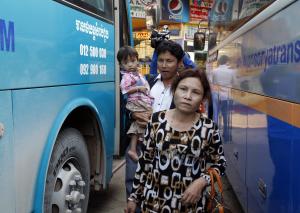
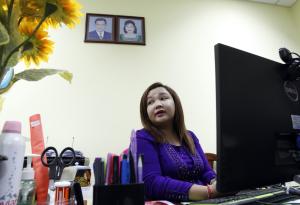
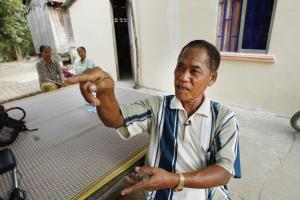
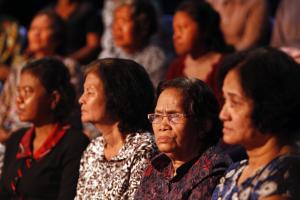
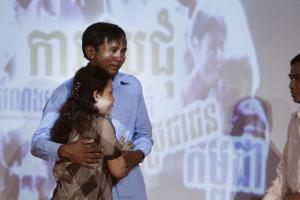

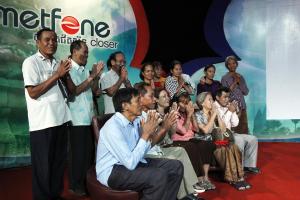
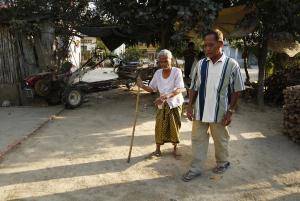
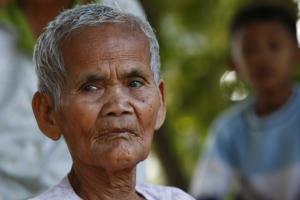
1 comment:
Begin of Drgunzet's comment.
The Cambodian government is establishing a Khmer Rouge Research center to make sure facts and evidences are archived to preserve history. As we all know, some Khmer with Khmer Rouge bloods are altering history to suit their purpose: to blame Vietnamese, to incite fight, to grab power.
This is why the Thais wanted to wipe out the Khmer race completely. They came and sacked Khmer capital again and again to make sure Khmer will never blame them. It worked. Khmer race no longer blamed Thais, but blamed Vietnamese.
So, if Vietnamese crushes the Khmer again, and again, the Khmer will start blaming the Thais. lol....
Establishing the KR Research Center is the best way to stop all the future Khmer Rouge and Vietnamese crushing/power-ownage.
I suggest the Khmer folks to stop causing trouble or you will be crushed again. See for yourself. How come all of you are so inferior as compared to me???
-Drgunzet-
Post a Comment